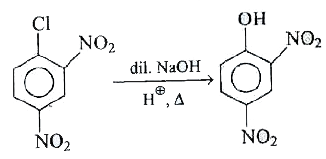An endothermic reaction proceeds faster in the forward reaction with decrease in temperature.
To determine whether the statement "An endothermic reaction proceeds faster in the forward reaction with a decrease in temperature" is true or false, we can analyze the concepts of endothermic reactions, activation energy, and the effect of temperature on reaction rates.
1. Understand Endothermic Reactions:
- An endothermic reaction is one that absorbs heat from its surroundings. In such reactions, the energy of the products is higher than that of the reactants.
2. Draw the Energy Profile Diagram:
- In an energy profile diagram for an endothermic reaction, the reactants have lower energy (Er) than the products (Ep). There is a transition state that has the highest energy, which is required for the reaction to proceed.
3. Identify Activation Energies:
- The activation energy (Ea) for the forward reaction is the energy difference between the reactants and the transition state. For the backward reaction, the activation energy is the difference between the products and the transition state.
4. Use the Arrhenius Equation:
- The rate constant (k) for a reaction is given by the Arrhenius equation:
k=Ae−EaRT
- Here, A is the pre-exponential factor, Ea is the activation energy, R is the gas constant, and T is the temperature in Kelvin.
5. Analyze the Effect of Temperature:
- For the forward reaction (endothermic), the activation energy (Ef) is larger than that for the backward reaction (Eb). Thus, as temperature decreases, the exponential factor e−EaRT decreases because Ea is positive and T is in the denominator.
6. Compare Rate Constants:
- The ratio of the rate constants for the forward and backward reactions can be expressed as:
kfkb=eEb−EfRT
- Since Eb<Ef for an endothermic reaction, Eb−Ef is negative, leading to a decrease in the ratio kf/kb as temperature decreases.
7. Conclusion:
- Since the rate constant kf for the forward reaction decreases with a decrease in temperature, the statement that "an endothermic reaction proceeds faster in the forward reaction with a decrease in temperature" is false. In fact, higher temperatures favor the forward reaction for endothermic processes.
- An endothermic reaction is one that absorbs heat from its surroundings. In such reactions, the energy of the products is higher than that of the reactants.
- In an energy profile diagram for an endothermic reaction, the reactants have lower energy (Er) than the products (Ep). There is a transition state that has the highest energy, which is required for the reaction to proceed.
- The activation energy (Ea) for the forward reaction is the energy difference between the reactants and the transition state. For the backward reaction, the activation energy is the difference between the products and the transition state.
- The rate constant (k) for a reaction is given by the Arrhenius equation:
k=Ae−EaRT
- Here, A is the pre-exponential factor, Ea is the activation energy, R is the gas constant, and T is the temperature in Kelvin.
- For the forward reaction (endothermic), the activation energy (Ef) is larger than that for the backward reaction (Eb). Thus, as temperature decreases, the exponential factor e−EaRT decreases because Ea is positive and T is in the denominator.
- The ratio of the rate constants for the forward and backward reactions can be expressed as:
kfkb=eEb−EfRT
- Since Eb<Ef for an endothermic reaction, Eb−Ef is negative, leading to a decrease in the ratio kf/kb as temperature decreases.
- Since the rate constant kf for the forward reaction decreases with a decrease in temperature, the statement that "an endothermic reaction proceeds faster in the forward reaction with a decrease in temperature" is false. In fact, higher temperatures favor the forward reaction for endothermic processes.
Topper's Solved these Questions
- CHEMICAL EQUILIBRIUMBOOK - CENGAGE CHEMISTRY ENGLISHCHAPTER - CHEMICAL EQUILIBRIUMEXERCISE - Archives (Multiple Correct)
6 Videos
- CHEMICAL EQUILIBRIUMBOOK - CENGAGE CHEMISTRY ENGLISHCHAPTER - CHEMICAL EQUILIBRIUMEXERCISE - Archives (Single Correct)
9 Videos
- CHEMICAL EQUILIBRIUMBOOK - CENGAGE CHEMISTRY ENGLISHCHAPTER - CHEMICAL EQUILIBRIUMEXERCISE - Exercises (Fill In The Blanks)
35 Videos
- CHEMICAL BONDING AND MOLECULAR STRUCTUREBOOK - CENGAGE CHEMISTRY ENGLISHCHAPTER - CHEMICAL BONDING AND MOLECULAR STRUCTUREEXERCISE - Archives Subjective
15 Videos
- CLASSIFICATION AND NOMENCLATURE OF ORGANIC COMPOUNDSBOOK - CENGAGE CHEMISTRY ENGLISHCHAPTER - CLASSIFICATION AND NOMENCLATURE OF ORGANIC COMPOUNDSEXERCISE - Analytical and Descriptive Type
3 Videos
Similar Questions
Knowledge Check
In endothermic reactions,
Areactants have more energy than productsBreactants have less energy than productsCreactants and products have same energyDreactants have lower temperature than products. , this reaction proceed through : Aelectrophilic additionBbenzyne intermediateCnucleophilic aromatic substitutionDoxirane
, this reaction proceed through : Aelectrophilic additionBbenzyne intermediateCnucleophilic aromatic substitutionDoxirane
The reaction which proceeds in the backward direction is
View SolutionA reaction occurs spontaneously in forward direction if
View SolutionAs the reaction proceeds, the rate of reaction:
View SolutionWhich condition is suitable for the forward reaction?
View SolutionWhich among the following reactions is favoured in forward direction by increase of temperature?
View Solutionlonic reactions are much faster than the molecular reactions.
View Solution
